Residency Programs
VA Long Beach Healthcare System (VALBHS)
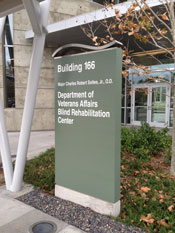
Established: 2012
Positions: Four
VA Long Beach Healthcare System – Major Charles Robert Soltes, Jr. Blind Rehabilitation Center
5901 East 7th Street
Long Beach, CA 90822
Building 126, 2nd Floor
Optometry Service
844.808.2020
Program Faculty
Chief of Optometry: Paula Matsuno, OD
Residency Coordinator: Edward Chu, OD
Staff Doctors: Kevin Yuan, OD; Catherine Tran, OD; Suzanne Wickum, OD; Rachel Young, OD; Julie Furness, OD; Jessica Nguyen, OD
Mission Statement
The Optometry Program at the VA Long Beach Healthcare System is a Primary Care/Low Vision Rehabilitation residency dedicated to educating the residents through serving the veterans. The residents will be provided a unique and extensive educational experience that will encompass comprehensive primary eye care as well as specialty eye care to include advanced low vision/blind rehabilitation and traumatic/acquired brain injury. The resident will be engaged in a collaborative and integrated approach in the delivery of eye, vision, and healthcare while maintaining the standards of integrity, commitment, advocacy, respect, and excellence.
Program Description
Program Goals
Goal 1: To strengthen the residents' primary eye care skills and ocular disease management
Goal 2: To train the residents' in developing advanced competencies in low vision eye examinations and traumatic brain injury cases
Goal 3: To provide the resident the opportunity to participate and integrate as an effective team member in a multidisciplinary healthcare setting
Goal 4: To engage the residents in didactic activities that will expand their knowledge base and will lead them on a path to developing life‐long learning skills
Goal 5: To instill in the residents the importance and value of professional development through scholarly activities and dissemination of knowledge
Goal 6: To provide the residents the opportunity to become effective educators through lecturing and precepting optometry students
Program Objectives
Objective 1.1: To maintain and strengthen the resident's optometric skills and advanced competencies in performing comprehensive primary care eye exams
Objective 2.1: To provide the resident with clinical experience in conducting comprehensive low vision eye examinations in an inpatient and outpatient VA setting.
Objective 2.2: To provide the resident with the opportunity to evaluate and manage traumatic and/or acquired brain injury cases, utilizing advanced competency optometric skills
Objective 3.1: The residents will play an integral part of the multidisciplinary team at the VALBHS.
Objective 3.2: The residents will develop an understanding of, and learn to utilize the support services that are available to them at the VALBHS.
Objective 4.1: To afford the residents opportunities to attend didactic lectures at VA Long Beach, locally and nationally
Objective 5.1: The residents will be mentored in the preparation of paper, poster, and lecture presentations
Objective 5.2: The residents will develop an understanding of keeping current with the latest evidence‐based publications and the application of the material to patient care and writing of the manuscript.
Objective 6.1: If the resident achieves a certain level of proficiency during the year as determined by residency coordinator and other attendings, resident will be given an opportunity to precept 4th-year optometry externs.
Objective 6.2 Residents will present lectures to co‐residents, staff, and externs regularly during the residency year
Duration of Residency Program
The residency will be one year in length commencing on July 1st and ending June 30th.
Typical Daily or Weekly Schedule in Clinic
- Clinic hours Monday through Friday 8:00 AM to 4:30 PM.
- Clinical care will take place at the Long Beach VA and Santa Ana Community Based Outpatient Clinic (CBOC)
- Clinic Schedules are:
- Primary Care: Monday through Friday (LB/SA)
- Outpatient Low Vision: Monday (LB), Thursday (LB), Friday (Santa Ana)
- Outpatient Traumatic Brain Injury: Tuesday (LB), Friday (LB/SA)
- Inpatient Low Vision: Monday through Friday (depending on admissions)
- Education (Journal Club, Grand Rounds): Wednesday PM
Facilities
VA Long Beach Healthcare System - The Major Charles Robert Soltes, Jr., O.D. Department of the VA Blind Rehabilitation Center (BRC)
The Long Beach VA will serve as the primary site for the residency. Optometry services are incorporated into the continuum of care in the BRC. At this location, primary care exams, Low Vision care, and TBI exams are provided on an inpatient and outpatient basis. In supporting the mission of consistently providing the highest quality of eye care to all patients, residents have access to four examination rooms for patient care, pre-testing / optical room, one special testing / imaging room, and a large conference room equipped with teleconferencing capabilities for inter-disciplinary meetings and presentations. Two exam lanes are designed for low vision, equipped with a large variety of low vision devices, in a wide range of powers. Being housed within the Blind Rehabilitation Center allows easy access to newer technologies and innovations with low vision, and rehabilitation, such as iPhone, iPad, and GPS. The other two exam lanes are generally for traumatic brain injury/ primary care and are equipped with new ophthalmic instruments and M&S acuity systems. The optical /dispensing room consists of ophthalmic frames, ophthalmic sunwear, and low vision filters. The special testing/ imaging room houses a Topcon fundus camera, Zeiss Cirrus-HD Optical Coherence Tomography (OCT), and Haag-Streit Octopus Visual Field. Residents are provided with office space and access to a personal computer. An internal email and instant messaging system allows for constant communication among faculty and residents. Faculty offices are in the same area as the residents and informal communication is encouraged.
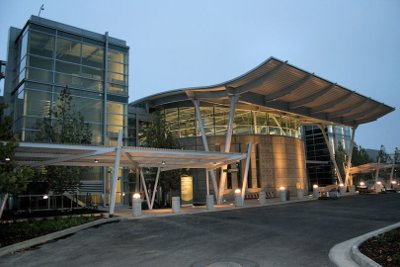
New Eye Department
The new Long Beach VA Eye Department opened in January 2021 and serves as the primary site for the residency. With 12 total rooms (10 exam lanes, 2 pre-test rooms) and up-to-date diagnostic clinic equipment including Cirrus 6000 OCT-Angiography, Clarus 500 Widefield Camera, Eidon AF true color confocal scanner, Eye Cubed Ellex B-Scan, anterior segment camera, fundus camera, and 2 Humphrey Visual Field Analyzer 3, Long Beach VA residents are given the opportunity to practice at the highest levels with state of the art equipment. In this new clinical setting, Optometry and Ophthalmology work side by side within a shared clinical space and we are excited for the new opportunities that this affords.
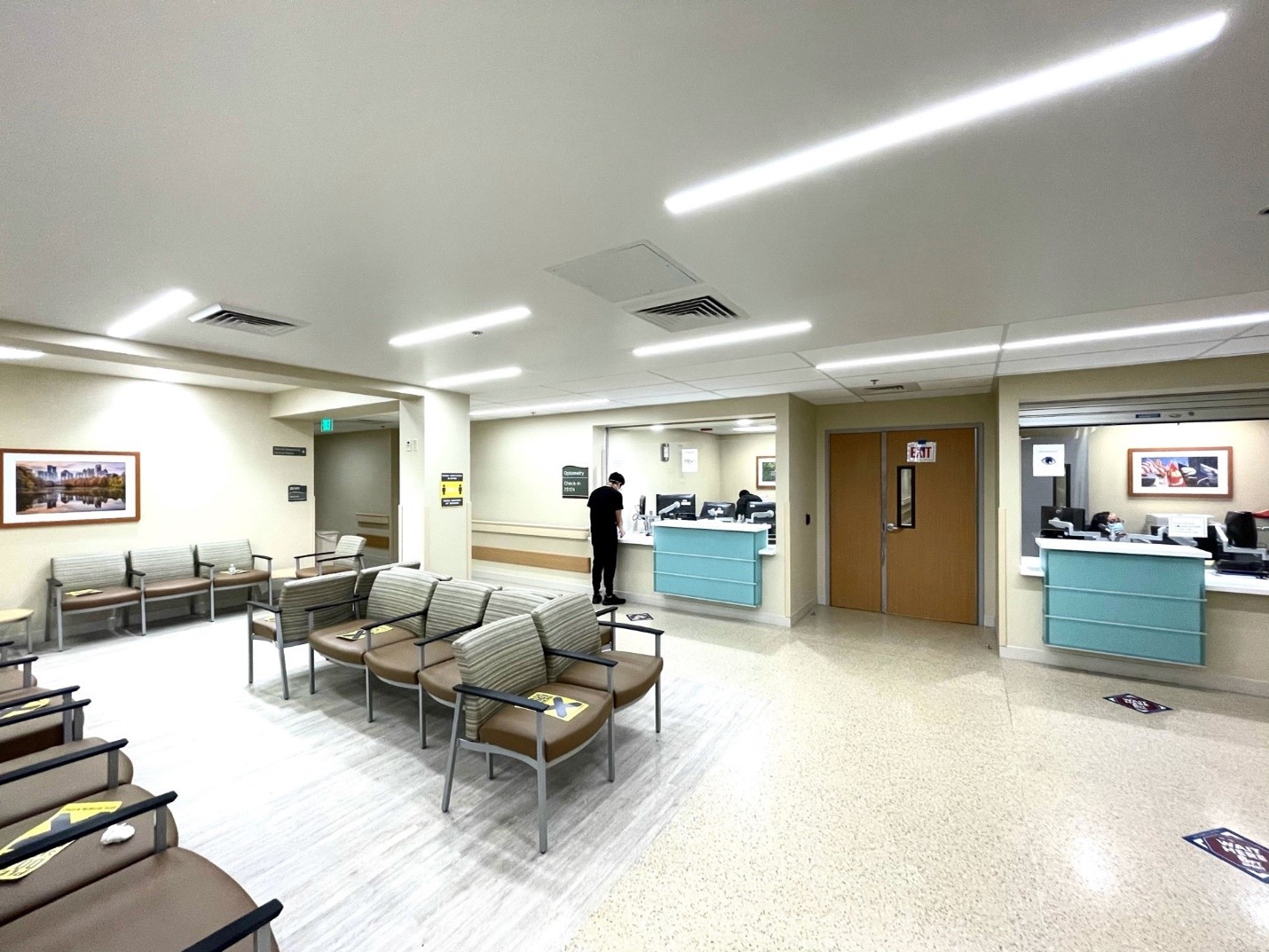
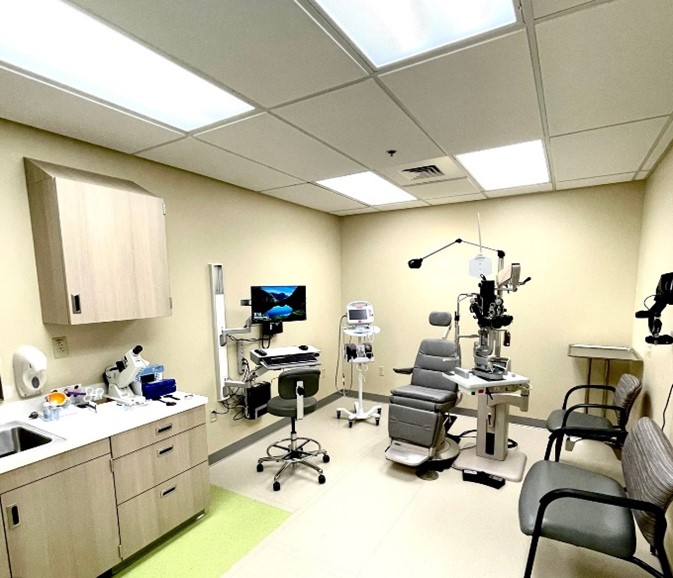
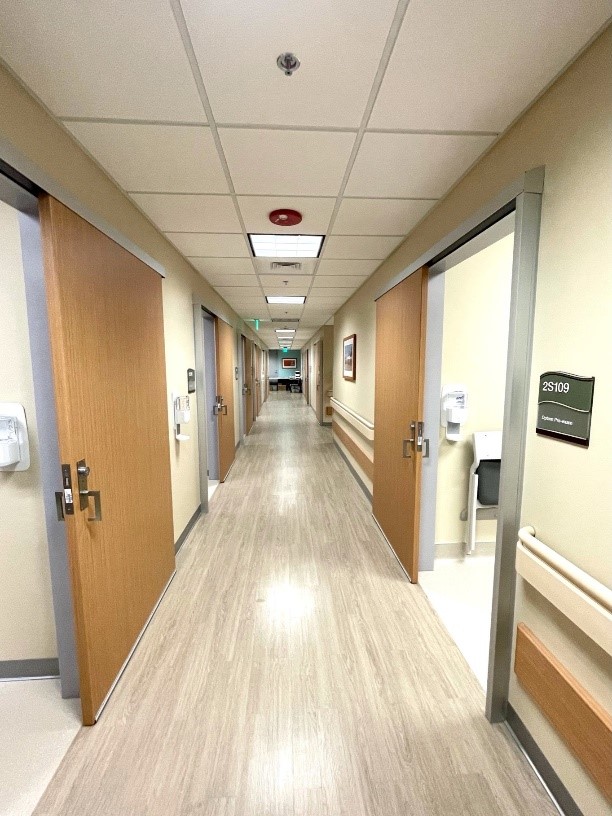
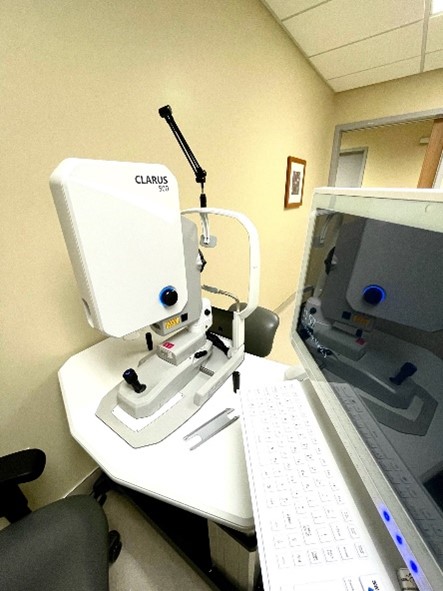
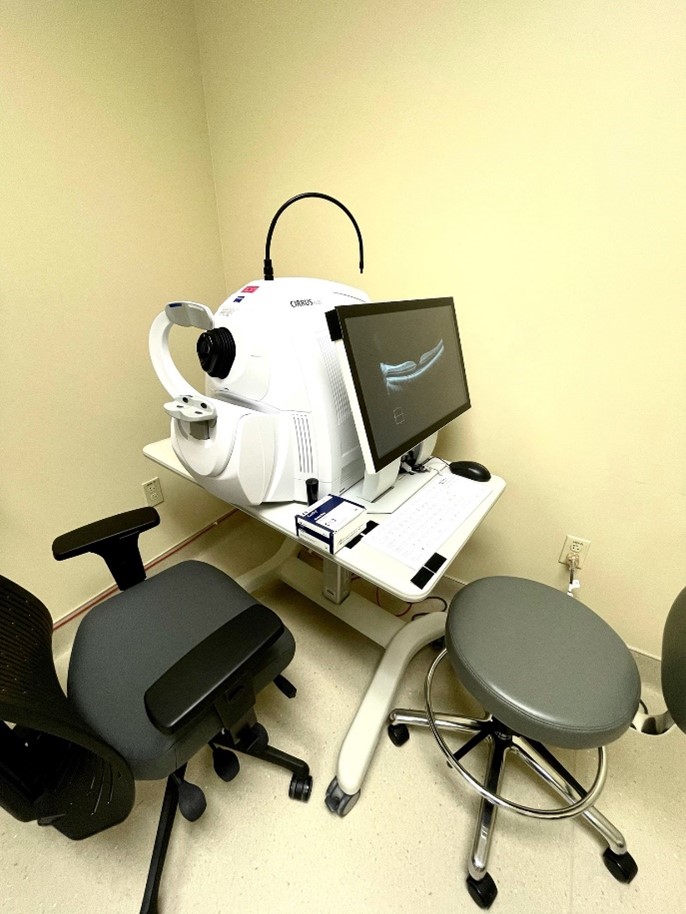
Santa Ana Community Based Outpatient Clinic
1506 Brookhollow Dr, Suite 118
Santa Ana, CA 92075
Residents will also spend significant time during the year at the Santa Ana CBOC. At this location, residents will mainly focus on primary eye care of patients, but will also be responsible for outpatient low vision, TBI exams and CL specialty fits. The clinic is fully equipped with Cirrus-HD OCT, anterior segment camera, fundus camera, and Humphrey Visual Field Analyzer 3.
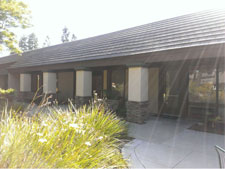 |
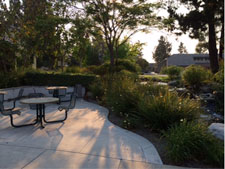 |
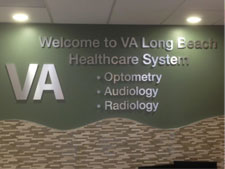 |
 |
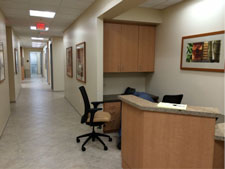 |
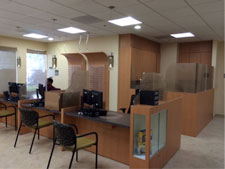 |
Rotation through other Services
The resident will primarily spend time seeing rehabilitative optometry patients in both low vision and traumatic brain injury. The opportunity to work with other disciplines in the Blind Rehabilitation Center will provide opportunities to observe rehabilitation in other disciplines, such as orientation & mobility, living skills, manual skills, and computer access technology.
Type and Number of Patients
VA Long Beach supports a wide age range of veterans. Each demographic is usually associated with its own clinical setting, such as younger veterans in TBI, middle-aged veterans in primary care, and the geriatric population in low vision. Approximately 80-90% of the resident’s time will be spent in direct patient care; other activities include clinical preceptorship of 4th year optometric externs (5%), administrative duties, didactic (5-10%), and scholarly activities (5%). The resident will perform comprehensive primary care and rehabilitative examinations, and consult with various health professionals ranging from ophthalmologist, occupational therapist, blind rehabilitation specialists, and traumatic brain injury clinicians.
Teaching Responsibilities
If a resident is judged by the staff to have reached a certain level of proficiency, the resident will be given opportunity to precept 4th year optometry externs in primary care clinics during the final quarter of the residency program under the supervision of residency faculty..
Lecturing Opportunities
The residents will rotate presenting cases to each other and the 4th year externs on a regular basis during our Wednesday afternoon education. In addition, the residents are required to participate in year-end Residency Forum at the Southern California College of Optometry with residents from other Ketchum affiliated sites.
Clinical Activities
- Primary eye examinations
- Low vision examinations
- TBI examinations
- Specialty contact lens fittings
- Visual fields (Humphrey VFA 3, Octopus, tangent screen, etc…)
- Fundus photography, OCT imaging/analysis, Anterior Segment Photos
- Referral of patients for ophthalmological subspecialty care
- Order consults (low vision devices, specialty low vision glasses)
- Training of low vision devices (electronic, hand held devices and bioptics)
- Observe blind rehabilitation specialties (Orientation Mobility, Living Skills, Visual Skills, Manual Skills, Computer Skills)
- Reviewing and completing consultations from other disciplines
- Referral of patients to other health disciplines
- Ordering lab testing, prescribing oral and topical medication
Didactic and Scholarly Activities
- Producing a manuscript of publishable quality by the end of the residency
- Weekly journal club to review current literature on ocular disease management
- Weekly grand rounds and case review
- Case presentations to other residents, students, and doctors during Education
- Presentation of case report at the Residency Forum at the Southern California College of Optometry
- Attendance at low vision in-services by low vision product vendors and/or optometrists
- Attendance at the AAO annual meeting (encouraged)
- Submission of poster for resident’s day or other national conference (required)
VA Long Beach Healthcare System Optometry Resident Poster and Paper Presentations
Ahmad, Sameera. “The Cat’s (Or Bat’s) Out of the Bag.” American Academy of Optometry Meeting, New Orleans, LA. October 2023
Alexander, Abby. “Before Jumping to Conclusions, Look for Occlusions.” American Academy of Optometry Meeting, Nashville, TN. October 2020.
Chen, Andy. “Functional Vision Loss in Traumatic Brain Injuries”. American Academy of Optometry Meeting, New Orleans, LA. October 2015.
Cruz, Emmeline. “Post-Trauma Vision Syndrome in the Combat Veteran.” American Academy of Optometry Meeting, Chicago, IL. October 2017.
Cruz, Michelle. “Exudative Retinal Arterial Macroaneurysm w/ Macular Edema in Patient Symptomatic for Changes in Migrainous Aura. American Academy of Optometry Meeting, Anaheim, CA. November 2016.
Du, Annessa. “Bilateral Disc Edema in a Patient with Anti-Hypertensive Therapy Noncompliance: A Multidisciplinary Approach.” American Academy of Optometry Meeting, Orlando, FL. October 2019.
Duran, P., Wong, M., ”Rehabilitation in Recent Onset Leber’s Hereditary Optic Neuropathy”, American Academy of Optometry Annual Meeting, Phoenix, AZ, October 2012.
Fakhra, Sahba. “Subretinal Clef Masking as Serous Detachment in CHRPE.” American Academy of Optometry Meeting, Anaheim, CA. November 2016.
Feng, Ashley. “The Case of the Disappearing Drusen.” American Academy of Optometry Meeting, Indianapolis, IN. November 2024.
Fernandez, Lauren. “The Challenges of Visual Rehabilitation in a Patient with Simultanagnosia and Neglect following Bilateral Occipital Stroke.” American Academy of Optometry Meeting, Orlando, FL. October 2019.
Furness, Julie. “Superior Segmental Optic Hypoplasia: The Tale of the Topless Disc.” American Academy of Optometry Meeting, Boston, MA. November 2021.
Gillett, Katherine. “Therapeutic Micro Prism used to treat Visual Symptoms in mTBI patients”. American Academy of Optometry Meeting, Seattle, WA.October 2013.
Gutierrez, Matthew. “Lost in the Shuffle: Pie in the Sky Defect following Silent Stroke.” American Academy of Optometry Meeting, Boston, MA. October 2025
Huang, Cynthia. “Green is the New Red: Diagnosing Normotensive Glaucoma Amongst Green OCTs. American Academy of Optometry Meeting, Boston, MA. November 2021.
Huang, April. “The Masquerading Nevus.” American Academy of Optometry Meeting, Nashville, TN. October 2020.
Jan, Maggie. “Time Course Evaluation and Treatment of Post-TBI Brain Tumor w/ Corresponding Visual Field Loss. American Academy of Optometry Meeting, Seattle, WA. October 2013
Kim, Rachel. “Visual Hallucinations: AMD, Alzheimer’s, or Both?” American Academy of Optometry Meeting, Nashville, TN. October 2020.
Lakkis, Yvette. “Aneurysm in an Unusual Location: Using OCT-A to Help Uncover a Diagnosis.” American Academy of Optometry Meeting, Indianapolis, IN. November 2024.
Lin, Rachelle J. “Co-Management of Diplopic Patient w/ Graves Orbitopathy”. American Academy of Optometry Meeting, Seattle, WA.October 2013
Lin, Rachelle J. “Determinants of Mesopic Visual Acuity”. American Academy of Optometry Meeting, Seattle, WA. October 2013
Lin, Rachelle J. “Mesopic Visual Acuity and Repeatability and Recommendations for Testing Standardization”. American Academy of Optometry Meeting, Seattle, WA. October 2013
Lin, Rachelle J. “Managing Diplopia of a TBI Patient with Cranial Nerve IV Palsy”. SECO Annual Meeting, Atlanta,GA. March 2013.
Nakano, Greyson. “Hemodialysis and the Optic Nerve”. American Academy of Optometry Meeting, Denver, CO. October 2014.
Nguyen, Angela. “Chorioretinitis Sclopetaria with Rupture of the Lateral Rectus due to Gunshot”. American Academy of Optometry Meeting, New Orleans, LA. October 2015.
Nguyen, Jessica. “Stress, Alcohol, and Hematemesis: A Recipe for Retinopathy. American Academy of Optometry Meeting, Boston, MA. November 2021.
Nguyen, Kevin. A clue to diabetic vision loss: Using OCT-A to assess foveal avascular zone and microvascular state in patients with reduced visual acuity and diabetes. American Academy of Optometry Meeting, San Diego, CA. October 2022.
Nguyen, Linh. “Retinal Astrocytic Hamartoma of the Optic Nerve without Systemic Association.” American Academy of Optometry Meeting, Nashville, TN. October 2020.
Nguyen, Tanya. “Purr-sistent Parasites: A Secret Hidden in the Fog.” American Academy of Optometry Meeting, Boston, MA. October 2025
Onallah, Sabreen. “A Squeamish Squamous Case.” American Academy of Optometry Meeting, Nashville, TN. October 2020.
Parekh, Puja. “CRAO w/ Large Disc Hemorrhage”. American Academy of Optometry Meeting, Denver, CO. October 2014.
Pham, Nina. A Sticky Attraction: Vitreopapillary Traction Impacting Glaucoma Management. American Academy of Optometry Meeting, San Diego, CA. October 2022
Phan, Linh. “Chorioretinal Folds: Wrinkles that Warrant Investigation”. American Academy of Optometry Meeting, Denver, CO. October 2014.
Phan, Mimi. “Treatment of Central Corneal Edema caused by Peripheral Spheroidal Degeneration”. American Academy of Optometry Meeting, Seattle, WA. October 2013.
Plechot, Eriq. Macular Degeneration and Cutaneous Lesions: A Potential Strategy for Identifying At-Risk Patients. American Academy of Optometry Meeting, San Diego, CA. October 2022.
Priest, Lara. “Lamellar Holes: A complication in the Age of Anti-VEGF.” American Academy of Optometry Meeting, Orlando, FL. October 2019.
Ramirez, Jeanette. Now You See Me, Now You Don’t: A Tale of an Old RVO. American Academy of Optometry Meeting, San Diego, CA. October 2022.
Shimokochi, Sara. Peripapillary CNVM Masquerading as Recurrent Drance Hemorrhage in Age-Related Macular Degeneration. American Academy of Optometry Meeting, San Diego, CA. October 2022.
Sprenkel, Andrew. “Occlusion, perfusion, or just pure confusion: Diagnosis of a chronic branch retinal vein occlusion using OCT Angiography.” American Academy of Optometry Meeting, Boston, MA. November 2021.
Tran, Catherine. “TBI with Loss of Eye and Traumatic Optic Neuropathy (TON) in Fellow Eye following Cannon Blast. American Academy of Optometry Meeting, New Orleans, LA. October 2015.
Tran, Kelly. “Superior Segmental Optic Nerve Hypoplasia: The Glaucoma Imposter.” American Academy of Optometry Meeting, Boston, MA. October 2025
Tran, Michael. “A Case of an Unruptured Retinal Arterial Macroaneurysm in an Asymptomatic Veteran.” American Academy of Optometry Meeting, Chicago, IL. October 2017
Vivirito, Mary D. “Management of Severe Photophobia Secondary to Chiari Malformation Decompression Surgery”. American Academy of Optometry Meeting, Denver, CO. October 2014
Vivirito, Mary D. “Talc Retinopathy”. Armed Forces Optometric Society Meeting, Denver, CO. October 2014
Vo, Jessica. “A Sharp Turn into the Right Diagnosis: Suspected Underlying Idiopathic Juxtafoveal Telangiectasia with concurrent Chronic Central Serous Retinopathy and Macular Schisis.” American Academy of Optometry Meeting, Indianapolis, IN. November 2024.
Vu, Julie. “Lipemia Retinalis: If At First You Don’t Succeed, Tri Tri Tri Again.” American Academy of Optometry Meeting, Boston, MA. October 2025
Wen, Mimia. “Spectral-Domain Optical Coherence Tomography as Means of Detecting Glaucomatous Changes in Patients with Confounding Temporal Lobe Encephalomalacia. American Academy of Optometry Meeting, Orlando, FL. October 2019
Wong, Jennifer. Peri-operative Ischemic Optic Neuropathy Following Cardiac Bypass Surgery. American Academy of Optometry Meeting, San Antonio. November 2018.
Yamane, Shawn. “Artificial Intelligence for the Eye: A New Lens on Vision Care.” American Academy of Optometry Meeting, Boston, MA. October 2025
Yang, Angela. “Invasive Fungal Sinusitis Complicated by Diabetes Mellitus: When It’s Not Just a Migraine.” American Academy of Optometry Meeting, Chicago, IL. October 2017.
Young, Rachel. “Removable Visual Prosthetic for Patients with Moderate to Severe Visual Impairment.” American Academy of Optometry Meeting, Anaheim, CA. November 2016.
Additional Employment Opportunities
Residents are expected to be at VA Long Beach Monday through Friday. This affords residents opportunities to moonlight or fill-in on weekends if desired.
There are no on-call duties for Long Beach VA Optometry residents.
Stipend
The annual stipend is established by the Office of Academic Affiliations, VA Central Office and is based on locality. It is currently set at $51,498 at our facility for the current academic year.
Benefits and Federal Holidays
| Health | Optional health insurance coverage is offered; biweekly premiums will be deducted. Long-term disability insurance is not provided. |
| Holidays | Each resident will have 10 paid Federal holidays during the residency year. |
| Educational Travel | “Authorized Absence” leave is granted for attendance at one professional continuing education conference such as the American Academy of Optometry (AAO) or American Optometric Association (AOA) annual meetings. |
| Vacation | Each resident accrues a yearly total of 13 days of annual leave and 13 days of sick leave. Unused annual leave is reimbursed after the conclusion of the year. |
| Liability | The VA provides malpractice coverage for VA-related patient care only. The resident must seek other malpractice insurance for any external clinical settings the resident chooses to participate in. |
| Continuing Education | The resident can attend SCCO sponsored continuing education courses at no cost on a space available basis. |
| Information Resources | Library resources are available to the resident through SCCO and the VA. |
| Life Insurance | Optional life insurance coverage through Federal Employees' Group Life Insurance is offered; biweekly premiums will be deducted. |
- New Year’s Day, January 1
- Martin Luther King Jr.’s Birthday, 3rd Monday in January
- President’s Day, 3rd Monday in February
- Memorial Day, last Monday in May
- Juneteenth National Independence Day
- Independence Day, July 4
- Labor Day, 1st Monday in September
- Columbus Day, 2nd Monday in October
- Veteran’s Day, November 11
- Thanksgiving Day, 4th Thursday in November
- Christmas Day, December 25
Application Requirements
Note that all residency applicants will be evaluated without regard to sex, sexual orientation, race, color, creed, age, national origin, or non-disqualifying physical disabilities.
- Applicant must have earned an O.D. degree, or will have earned such a degree by the time of graduation, from an ACOE accredited school or college of optometry.
- If the applicant is a citizen of a country other than the United States, that applicant will not be eligible for residency consideration.
- Applicant must have taken and passed the Basic (NBEO Part 1), Clinical Sciences (NBEO Part 2) and TMOD portions of the National Board of Examiners in Optometry, and furnish official copies of the results of this examination If the candidate did not pass any portion of the NBEO exam, then the applicant will not be eligible for interview except under extenuating circumstances.
- Applicant must apply through the Optometry Resident Match (ORMatch) and follow the application guidelines. The application deadline is January 30. This deadline is to express interest in the program via ORMatch application, not necessarily to have all application materials submitted.
- A personal interview is required (in person or via Zoom/Facetime).
- Applicants should send application matching materials to Optometry Resident Match (ORMatch)
- Applications will be evaluated by the Long Beach VA Residency Admissions Committee who will rank candidates accordingly.
- If accepted, the applicant must provide official NBEO and official transcripts of their optometric education and submit them to the Ass. Dean of Residencies at SCCO.
Required paperwork for residency applicants:
- Curriculum Vitae (CV)
- Letter of intent
- Three (3) letters of recommendation preferably from instructors who are familiar with your clinical work.
- Official optometry school transcripts up to the time of your application
- Official NBEO transcripts
Selection Procedure
Potential applicants are required to submit their applications to the residency program via the ORMatch and should contact the Residency Coordinator, Dr. Edward Chu, via email expressing interest in the program and intent to apply. Candidates who qualify will be invited for an in-person interview at Long Beach VA where they will be given a tour of the clinic/hospital, meet the current residents, and speak with interview committee.
In the individual interview, candidates will be asked questions that include, but are not limited to, what motivates them to pursue residency training, why they are interested in our specific program, what their career aspirations are, and how they will enhance our program. The candidate will also be asked their thoughts regarding the management of various primary care cases. Following the interview, the interview committee tabulates an overall score based on:
| Interview | 25% |
| GPA | 10% |
| NBEO scores | 10% |
| Letter of Intent | 10% |
| Letters of Recommendations | 20% |
|
Special qualities/characteristics:
|
25% |
The candidate will be ranked based on the above merits; however, approximate weights are placed on each by the Residency Coordinator and interview committee. The ranking of all candidates is submitted to ORMatch for matching.
Requirements for Residency Completion and Awarding of Certificate
- The resident is required to keep a detailed log and report the following: Patient Encounter and Diagnosis Log, Faculty Evaluation, Referral Log, Activity Log, Reading Log, and Final Evaluation of Residency Program. All of the submissions will be reviewed by the Asst. Dean of Residencies and the Residency Coordinator.
- The resident is required to provide patient care services at a level deemed satisfactory to the Chief of Optometry / Residency Coordinator in line with the highest levels of current optometric standards of practice.
- The resident is required to submit a paper based upon original research, literature review, and/or clinical case or cases suitable for publication in a peer reviewed optometric journal. Topic for the case report or research project is made by September 1st; the abstract of the case report or research project is due on November 1st; the 1st and 2nd draft of the paper is submitted by February 1st and April 1st respectively; and the final paper is due on June 1st.
- The resident is expected to deliver patient care services in a professional manner and to observe those proprieties of conduct and courtesy that are consistent with the rules and regulations governing SCCO and the VALBHS.
- At the conclusion of the residency program, the resident must go through an “out process” which includes turning in his or her VA badge, keys to the facility, clinic coats, and de-activated in the computer system.
Program Accreditation
The Accreditation Council on Optometric Education (ACOE) has granted the VA Long Beach Healthcare System Residency Program the accreditation status of “Accredited.” The next scheduled site visit will take place in April 2030. Accredited is a classification granted to an educational program indicating that the program generally meets the Standards for accreditation. For more information, see the ACOE’s website at www.theACOE.org or contact the ACOE at accredit@theacoe.org.
Accreditation Council on Optometric Education
243 N. Lindbergh Blvd., Suite 301
St. Louis, MO 63141
Phone: 1-800-365-2219
E-mail address: accredit@theacoe.org
Housing
Long Beach VA is located in East Long Beach next to California State University Long Beach, and therefore there are many different housing options in the vicinity. The Santa Ana CBOC is located close to where the 405 South freeway and 55 freeway meet, a few miles from the South Coast Plaza Shopping mall. When deciding where to live, residents should keep morning traffic in mind and take note that clinic hours are 8:00 – 4:30 at both Santa Ana and Long Beach VA clinics.
Local Activities and Attractions
Long Beach is centrally located within the Los Angeles and Orange county area, making it convenient to drive to museums, shopping malls, and music venues. It is in close proximity to many of the famous beaches, and sporting events in Southern California. Long Beach is also a big port city in which many cruise lines depart from.
Some of the bigger attractions are listed below:
- Disneyland
- Universal Studios
- Knott’s Berry Farm
- Hollywood
- Catalina Island
- Joshua Tree National Park
- Six Flags Magic Mountain
- Temecula Vineyards
- Las Vegas
- San Diego
- Big Bear Lake
Current Residents
Matthew Gutierrez, O.D.
O.D. Marshall B. Ketchum University
MatthewAllen.Gutierrez@va.gov
Tanya Nguyen, O.D.
O.D. Berkeley Optometry
TanyaThaovy.Nguyen@va.gov
Kelly Tran, O.D.
O.D. University of Houston College of Optometry
Kelly.Tran16@va.gov
Julie Vu, O.D.
O.D. Marshall B. Ketchum University
Julie.Vu1@va.gov
Shawn Yamane, O.D.
O.D. Marshall B. Ketchum University
Shawn.Yamane@va.gov
Contact Information
Edward Chu, O.D.
Staff Optometrist/ Residency Coordinator
VA Long Beach Healthcare System
Mjr Charles Robert Soltes, Jr. Blind Rehabilitation Center
5901 East 7th Street
Long Beach, CA 90822
844-808-2020
Paula Matsuno, O.D.
Chief of Optometry
VA Long Beach Healthcare System
Mjr Charles Robert Soltes, Jr. Blind Rehabilitation Center
5901 East 7th Street
Long Beach, CA 90822
844-808-2020
Judy W.H. Tong, O.D.
Assistant Dean of Residencies
Southern California College of Optometry at
Marshall B. Ketchum University
2575 Yorba Linda Blvd.
Fullerton, CA 92831-1699
714.449.7429 • Fax: 714.992.7811
Email: jtong@ketchum.edu
